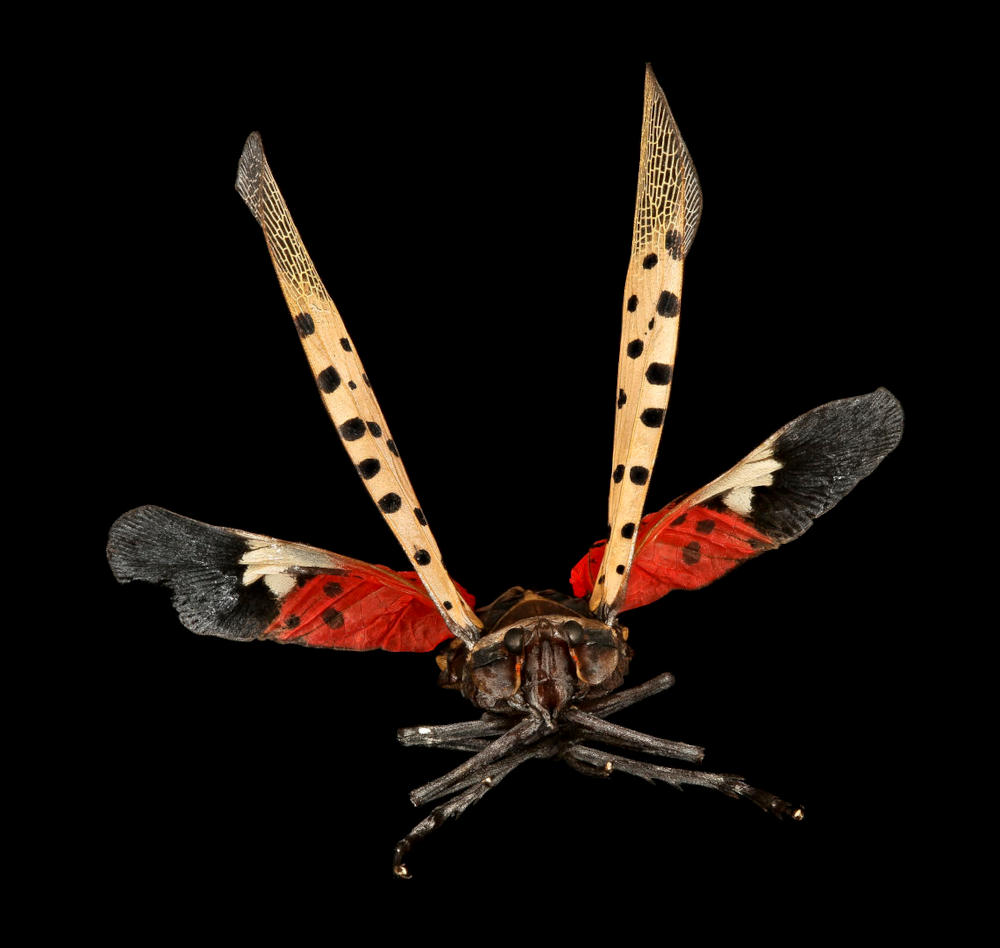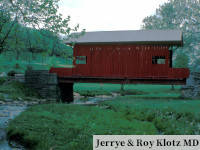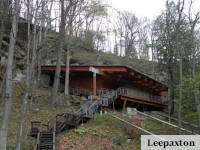Watch Out For The Spotted Lanternfly

The destructive spotted lanternfly (SLF) is alive and flying in Washington County and four adjacent counties. Quarantines and other efforts are underway to keep the bugs under control.
At the peak of SLF season in 2023, the pest, which doesn’t bite or sting people, is swarming. Worse than annoying, it ruins and can kill domestic plants that are good for the environment and power the economy – grape vines, fruit tree, plant nurseries and trees in the timber industry. The SLF can cost the PA economy hundreds of millions of dollars a year.
The attack of the spotted lanternfly causes plants to ooze sap and wilt, and their leaves to curl. The SLF excretes a lot of honeydew, a sugary substance that encourages a messy, sooty mold to grow. The plants can suffer dieback – the tips of their branches are dead. Trees, vines and other crops can die.
Originally from Asia, the SLF was first “spotted” in PA in 2014. By 2023, it was active enough to be quarantined in 51 counties.
Actually counting the number of spotted lanternflies looks like an insurmountable problem. The size of the SLF population is certainly growing. A single female SLF lays dozens of eggs in each mass that she deposits.
We face potentially the worst invasive pest since the introduction of the gypsy moth nearly 150 years ago
Rick Roush, dean of the College of Agricultural Sciences at PennState, quoted in PennState’s Ag Science Magazine
A county is placed under quarantine when evidence of a reproducing population of spotted lanternflies, such as an egg mass, is found, according to the PA Department of Agriculture.
Across the state, the spotted lanternfly is a huge threat to the agriculture industry, the PA Department of Agriculture writes.
If not contained, spotted lanternfly potentially could drain Pennsylvania’s economy of at least $324 million annually.
Laura Delach, Penn State Extension Master Gardener Coordinator for Washington County
Allegheny, Beaver, Fayette, Washington and Westmoreland Counties in southwestern PA are in the SLF quarantine zone. Greene County is not presently on the quarantine list. Those are the five PA counties that border Washington County.
The SLF could ding the local economy.
Portions of Washington County are heavily wooded. Hundreds of people are employed here in forest product jobs. The trees locally are at risk for being damaged by that pest if they enter the county.
Washington County has wineries. The spotted lanternfly reduce grape yields, and damages or kills grape vines. Unchecked, the vineyards that support the wineries could reduce their production unless they’re aware of programs that can help them – like multiple applications of insecticides. Getting rid of the bugs increases the cost of crop production, which could drive up the price of fine local wines.
People learning about the dangers of the spotted lanternfly is part of controlling them. “The more people who are aware and knowledgeable about SLF the higher chance of controlling the insect invasion,” Delach wrote.
An adult spotted lanternfly is relatively big for a sucking insect – 1-inch to 2-inches long and ½ inch wide. At rest, natural camouflage allows them to blend against tree bark, making them difficult to see. When they spread their wings in flight, their bright red wings and black dots on a gray background make them identifiable. The USGS Bee Inventory and Monitoring Lab refers to them as beautiful, but scary.
People can snap a photo on their phone and compare it with actual spotted lanternfly photos that PennState posted to Have you seen a spotted lanternfly? Let’s check! If they match, a report can be filed right there.
The PA Department of Agriculture urges people who see a spotted lanternfly to report it right away by calling 1-888-4BADFLY.
Kill it! Squash it, smash it…just get rid of it.
PA Department of Agriculture
The spotted lanternfly doesn’t have any natural enemies in PA to keep their numbers in check – that’s why they spread so fast. More than 25 College of Agricultural Sciences faculty, Penn State Extension educators, research technicians and graduate students work to understand the bug’s biology, the economic damage it does and how well it can be controlled with biological and chemical approaches. Here’s what works:
- A spotted lanternfly quarantine has been established in 26 PA counties to limit the spread of the bugs. The quarantine regulates the movement of landscaping, remodeling or construction waste, logs and stumps, nursery stock, crates and pallets, outdoor household articles and other articles that may harbor the insect.
- A parasitoid introduced to the U.S. from Asia, where the spotted lanternfly originated, eats SLF egg masses. A parasitoid is usually an insect that lives on or in its host and eventually kills it.
- “Two naturally occurring fungal pathogens of spotted lanternflies have been identified in the U.S.,” Professor Frank Hale, a professor at the University of Tennessee and an entomologist who is tracking this species, wrote in The Conversation.
- Contractors are removing the tree of heaven, a plant that is native to Asia, from public property. The SLF prefers those trees. Getting rid of them eliminates its preferred habitat.
- In a different approach, trees of heaven become a “food truck to lure the spotted lanternflies away from the grapevines,” Amy Duke wrote in So Long Spotted Lanternfly, an article from the PennState College of Agricultural Sciences. The trees are treated with a pesticide that kills the SLF. The bugs are drawn to the trees, suck up the tainted sap and die.
- The spread of the SLF could be slowed by spraying an insecticide containing dinotefuran on the leaves of trees that the bugs are drawn to, based on a PennState Extension-led study. The insecticide would be applied in the spring when the bugs’ eggs hatch, reducing satellite populations of the pest
- More than 14 insecticides are known to reduce populations of the SLF.
In the fall, those bugs lay egg masses with 30 to 50 eggs each. When the masses are laid on flat surfaces of trucks, the eggs can be transported across county lines and survive the winter. An influx of spotted lanternflies can damage the environment. In parts of eastern PA where the bugs entrenched themselves, they affect how people enjoy the outdoors, and they eat and damage trees and other plants.
Washington County and 4 neighboring counties are in the spotted lanternfly quarantine
This article was published in and updated in








